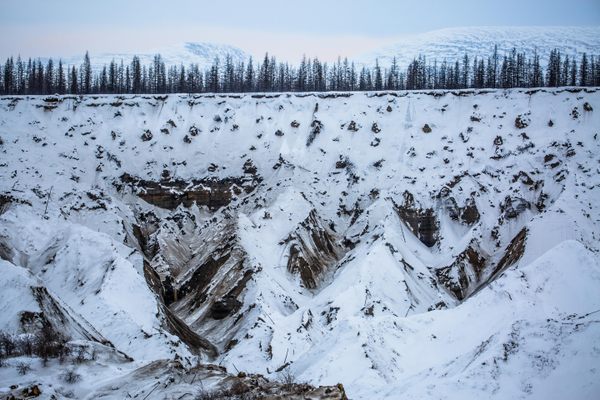The Best Visualization of Climate Change isn’t a Graph—It’s a Death Spiral
If you think you’re hot right now, just wait.

NOAA’s land & ocean temperature records for April, 2016. Global temperatures can be broadly summarized as “unseasonably warm.” (Illustration: National Oceanic and Atmospheric Administration/Public Domain)
It’s been unseasonably warm this past week in Atlas Obscura’s headquarters New York City, with temperatures about ten degrees higher than average. But that’s not really as noteworthy, as say, India recording its hottest day ever, at 123.8º Fahrenheit on May 20th. Globally, 2016 is on track to be the hottest year on record, surpassing the current record-holder, 2015. In fact, since 2014, every successive year has been the “hottest year on record.”
Detecting a pattern?

It is and will continue to be hot in here. (Illustration: Jay Alder, U.S. Geological Survey/Public Domain)
How about now?
This animated spiral, created by Jay Alder of the U.S. Geological Survey, is an extension of a spiral created earlier this month by climate scientist Ed Hawkins. Hawkins’ original spiral depicted the observed monthly global average temperatures (as presented in the HadCRUT 4 dataset) relative to the mean temperature for 1850-1900. The spiral makes the overall trend of global warming—and particularly the increased pace of warming since 1980—immediately obvious.
Inspired by Hawkins’ novel approach, Alder has expanded the spiral to included predicted temperatures through 2100. It’s the opposite of chilling.
To model the future temperatures, Alder used the Community Climate System Model (CCSM4), a global climate model maintained by the National Center for Atmospheric Research and funded by National Science Foundation and U.S. Department of Energy. The CCSM allows researchers to create computer simulations of Earth’s climate states past, present, and future by simultaneously simulating Earth’s atmosphere, ocean, land surface, and sea-ice.
Using the CCSM, Alder used the simulation for the IPCC Representative Concentration Pathway 8.5 (RCP8.5) emission scenario, which posits that greenhouse gas emissions remain unchecked and rise to a level four times the current atmospheric concentration by 2100. The RCP8.5 is essentially the worst-case scenario—other RCPs assume that emissions will drop substantially at some point in the next century—but the question isn’t whether temperatures (and sea levels) will continue to rise through the end of the century, just how much.
In short, Hawkins and the USGS has provided us with a visually appealing, easy-to-understand graph of our global warming death spiral. You can even pair it with a similarly informative sea ice death spiral!
@ed_hawkins I presume you’ve seen the Arctic sea ice variant of this by @ahaveland aka the “death spiral” pic.twitter.com/UvvDfFf0k4
— James Screen (@polar_james) May 10, 2016
While the spiral’s implications are alarming, the temperatures predicted aren’t yet guaranteed. Hawkins’ original spiral highlights the 1.5º and 2.0º Celsius temperature increase limits suggested by the recent Paris Climate Agreement. Keeping global warming below 1.5º may already be impossible; a report from Climate Central claims that we actually already surpassed that mark in February, based on data reported by NASA and NOAA. And “three months do not make a year,” as Climate Change puts it, anyway.
But if global emissions can be cut enough to put us on one of the more “optimistic” RCPs, like RCP2.6, we stand a real chance at keeping global temperatures below the 1.5º C threshold. “Humans are largely responsible for past warming,” wrote Hawkins put it in the blog post accompanying his original spiral, “so we have control over what happens next.”










Follow us on Twitter to get the latest on the world's hidden wonders.
Like us on Facebook to get the latest on the world's hidden wonders.
Follow us on Twitter Like us on Facebook